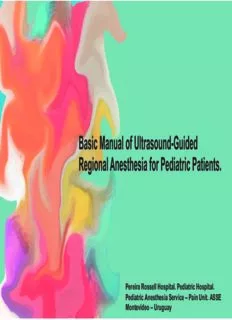
Basic Manual of Ultrasound-Guided Regional Anesthesia for Pediatric Patients PDF
Preview Basic Manual of Ultrasound-Guided Regional Anesthesia for Pediatric Patients
Basic Manual of Ultrasound-Guided Regional Anesthesia for Pediatric Patients. Pereira Rossell Hospital. Pediatric Hospital. Pediatric Anesthesia Service – Pain Unit. ASSE Montevideo – Uruguay Cristiani, Federico Basic Manual of Ultrasound-Guided Regional Anesthesia for Pediatric Patients. 1ST Edition. ISBN: 978-9974-99-444-2 © Federico Cristiani Cover page and Graphic Design: Carolina Hernández ISBN: 978-9974-99-444-2 Legal Deposit: 364303 Printed in Uruguay – April 2014. AUTHORS Pain Unit. Pediatric Anesthesia Service. Pereira Rossell Hospital (CHPR) ASSE. Montevideo – Uruguay Dra. Gabriela Castro Dra. Sofia Castelli Dra. Alejandra Hernández Dr. Federico Cristiani Dra. Gabriela Lopez Contact: [email protected] Contributor: Dr. Gustavo Armand Ugon. Prof. Anatomy Dept. UdelaR (University of the Republic). Acknowledgements: Dr. Clarisa Lauber. Chief of the Pediatric Anesthesia Dept. CHPR. ASSE. Translation: Dr. Alejandra Hernández with assistance from Dr. Karen Boretsky. 1 Index Introduc�on Lower extremity. Lumbosacral plexus block Basic principles for regional anesthesia in pediatrics. Ÿ Femoral nerve Ÿ Obturator nerve Basic principles of ultrasound imaging. Ÿ Lateral femoral cutaneous block Ÿ Scia�c nerve. Subgluteal approach Needle and transducer rela�onship Ÿ Scia�c nerve. Popliteal approach Trunk Blocks Neuraxial block Ÿ Thoracic paravertebral Ÿ Transversus abdominis plane (TAP) Ÿ Caudal block Ÿ Rectus sheath Ÿ Ilioinguinal and iliohypogastric Local anesthe�c toxicity Upper extremity. Brachial plexus block. Ÿ Interscalene Ÿ Axillary Ÿ Supraclavicular Ÿ Infraclavicular 2 3 Introduction Pain is one of the most common postopera�ve complica�ons in pediatric anesthesia. The advantages of using regional anesthesia include pain preven�on, prolonged analgesia, less opioid and muscle relaxant requirement, shorter hospital stays and increased pa�ent and family sa�sfac�on. The introduc�on of ultrasound machines to the daily anesthesia prac�ce has encouraged the use of regional anesthe�c techniques, especially in pediatrics where these procedures are performed under deep seda�on or general anesthesia. Historically, widespread use of these techniques was limited due to concerns of increased risk of nerve injury, inadvertent puncture of different structures as well as masking of signs and symptoms of local anesthe�c systemic toxicity. The use of ultrasound guidance allows a safe and effec�ve performance of a regional block in pediatric pa�ents. Anesthesiologists beginning their training in regional anesthesia need to consider that a learning curve comes with prac�ce; and that working in collabora�on with surgical teams from different special�es will help with the acquisi�on of appropriate training. The aim of this manual is to provide the anesthesiologist easy and fast access to the most frequent regional blocks in pediatric anesthesia. 4 Using ultrasound in regional anesthesia Advantages I – Direct visualiza�on of nerves and vascular structures (less risk of intraneural or intravascular injec�on) II - Real �me visualiza�on of needle inser�on, allowing adjustments in direc�on and depth. III - Facilitates the approach in pa�ents with distorted anatomy or with difficult recogni�on of surface landmarks. IV – Direct visualiza�on of local anesthe�c spread together with the possibility of needle reposi�oning if necessary. V – Smaller doses of local anesthe�cs can be used, diminishing the risk of toxicity. VI – Compared to neuros�mula�on-based techniques, ultrasound improves the quality, �me and success rate of the sensory block. 5 Basic considerations regarding regional anesthesia in pediatrics Ideally, to op�mize peri-opera�ve analgesia, a nerve block should be done previous to the surgical incision. A secure airway, intravenous line and basic monitoring must be established prior to the procedure. Materials for reanima�on/ resuscita�on, including 20% lipid emulsion, must be available. Local anesthe�cs: 0.2% Ropivacaine or 0.25% Bupivacaine. Maximum dosage: 2.5 mg/kg Infants under 6 months of age: Use 50% of the usual dosage. If there is increased resistence to injec�on, stop injec�ng and change needle direc�on Remember contraindica�ons for regional anesthesia *Do not use over 2 mg/kg of local anesthe�cs for thoracic paravertebral or intercostal block. 6 Basic ultrasound management Transducer selec�on: ·Linear (High frequency 6 to 18 MHz) for superficial structures (up to 4-5 cm depth). The linear transducer is the most widely used transducer in pediatric popula�on. It is important to chose the correct contact surface size. In smaller children, the golf-club (hockey s�ck) shaped linear transducer can be appropriate. Depth: Start by using maximum depth in order to iden�fy the anatomical structures in the region and measure the distance between the target structure and the skin. Gain: Controls the brightness of the image on the ultrasound screen and is used to obtain a darker or lighter screen. When the target nervous structure is surrounded by muscle, decreasing gain may allow for be�er visualiza�on of the perineural sheath. If surrounded by fat, increasing gain may create a brighter image. Recording and picture taking: It will depend on the ultrasound machine model. 7 Transducer and Needle direction NEEDLE – TRANSDUCER RELATION TRANSDUCER – TISSUES RELATION IN PLANE NEEDLE SHORT AXIS OUT OF PLANE NEEDLE LONG AXIS 8
Description: